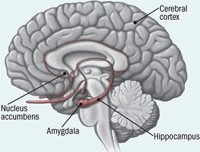Sunday, 25 September 2016
How Different Parts of the Brain Co-operate

Perhaps one of the hardest things to understand about the brain is the way that it is organized into networks. In this post, I will discuss a 2015 study, on the brain structures involved in delayed gratification, that makes this complex subject a bit easier to grasp.
But first, let’s review the basics of what makes this subject so complex, using the amygdala as an example. Starting in the 1990s, research done on the amygdala in Joseph LeDoux’s laboratory clearly demonstrated this structure’s involvement in an animal’s fear response to a perceived threat. As a result, the amygdala was somewhat hastily labelled the brain’s “alarm system”. But subsequent research showed that the amygdala is also highly active in other, very different situations—such as when someone is very hungry, or sees a loved one suffering. The idea thus developed that the activity of the amygdala produces not simply fear, but rather a form of intense concern with any of a variety of situations that are vital to the organism. Such concern may induce someone to flee a threat, but may also induce them to eat when they are hungry, or to provide care to a loved one who needs it. (Other researchers, such as Luiz Pessoa, have pointed to an even broader range of possible roles for the amygdala.)
Against this background, it is interesting to consider a study published in July 2015 by Andrew R. Abela and his colleagues, entitled “Hippocampal interplay with nucleus accumbens is critical for decisions about time”. Abela is talking about the interplay between two brain structures that have usually been regarded as having very different overall functions: in the case of the hippocampus, memory and planning (you retrieve memories to plan your future actions more effectively), and in the case of the nucleus accumbens, pleasure.
In Abela’s study, the researchers found that when they interrupted the connections between these two structures in rats, they became incapable of waiting a little bit longer to receive a larger reward than they would if they did not wait. The ability to wait for a larger reward, known as delayed gratification, is a phenomenon well known to psychologists, who have observed it in humans as well as in rats. This points to a fairly ancient evolutionary origin involving these two parts of the brain, and possibly other parts as well, especially in human brains, which are substantially more complex. (For full details on this study, follow the two links below.)
What makes this study so interesting is that it shows how an elaborate behaviour that enables an animal to delay gratification requires a dialogue between two brain structures, each of which is involved in a particular aspect of that behaviour: the nucleus accumbens in the experience of pleasure, the hippocampus in planning a delay before enjoying that experience. It is therefore the connections joining these two distinct brain structures that enable the emergence of the behaviour, further demonstrating the importance of a networked conception of the brain. This particular experiment examined the brains of rats, but showed that even in these animals, the brain is already employing a sort of neuronal recycling to accomplish a new, more complex task.
This concept of neuronal recycling also helps us to better understand how various parts of the brain that evolved in response to certain evolutionary pressures long, long ago can be reused now for other purposes, in particular in the human brain, which is now evolving in an entirely different environment. One good example of how productive this approach can be is the development of the hypothesis of a common evolutionary origin for spatial orientation and declarative memory in humans (which again, as it happens, involves the hippocampus).
![]() Brain Structures Involved in Delayed Gratification Identified
Brain Structures Involved in Delayed Gratification Identified
![]() Hippocampal interplay with the nucleus accumbens is critical for decisions about time
Hippocampal interplay with the nucleus accumbens is critical for decisions about time
Pleasure and Pain | No comments







